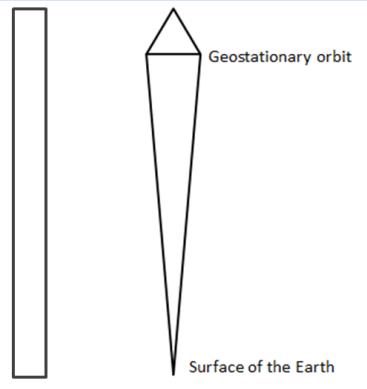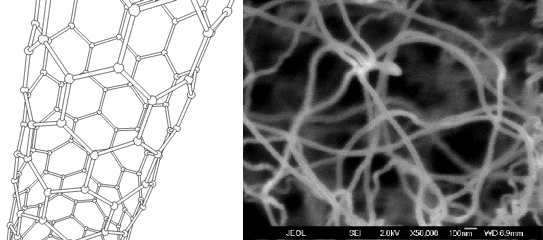Ever since the first human being looked up to the starry night, the dream of chasing the stars and space has never stopped. A long way back, in ancient Northern European mythology, the world tree, Yggdrasil, was a holy tree in the center of the universe, connecting the heavens and the earth. In Jack and the Beanstalk, the young English lad climbs all the way into the sky through a gigantic beanstalk. The everlasting dream of sky-reaching trees, from the Tower of Babel in the Bible to the Jian Mu Tree in the Chinese classic Shanhaijing, has indeed inspired people from generation to generation to explore the sky. In time, numerous unimaginable technologies have been brought to the world: rockets, satellites, spaceships. And now, science has given the dream of the sky-reaching tree a new name: the space elevator.

A space elevator, as is implied by the name, is an elevator-like transportation system connecting the surface of earth to space. People want it because it provides a means of shipping cargo into space with lower cost and pollution. The concept of the space elevator was first conceived in 1895 by Konstantin Tsiolkovsky, a Russian rocket scientist. Inspired by the Eiffel Tower in Paris, his conceptual tower, just like a sky-reaching tree, has the height of a geostationary orbit, a circular orbit 35,786 kilometers above the earth’s equator.
Two Potential Designs
However, if we try to build such a sky-reaching tower brick by brick, this would mean building a base to support the tower’s weight from below. This is called a compression structure, and unfortunately no material in existence has enough compressive strength to allow us to build such a thing. At such a height, the tower will certainly crack under its own weight. To solve the problem, in 1959, another Russian scientist, Yuri N. Artsutanov, devised a potential solution, known as a tensile structure. In contrast to the compression structure, the tensile structure holds up the weight of the system from above; think about how a tent is supported by rods. As it turns out, it is more feasible to find a material with enough tensile strength (ability to withstand these “pulling” forces), so most of the ideas since then have been based on the tensile structure.

The basic design usually includes a base station, a cable, climbers, and a counterweight. Imagine you have a strong rope like a clothesline with a heavy item, say, your coffee mug, at the end of the rope. Now you rotate in place (I know you’re dizzy now), and try to get the mug to rotate with you (but don’t break it!). At a certain range of rotation speeds, the rope in your hands will become taut and the mug will spin with you. This is just like a space elevator with a tensile structure. With the rotation of the Earth, the cable connecting the Earth and the counterweight remains stretched taut under the upward centrifugal force that counters gravity. A base station anchors the cable at the equator, just as you were holding the rope in your hand. A counterweight, like your coffee mug, is something heavy enough to hold the system aloft. People have proposed several solutions for the counterweight of this incredible size—like a captured asteroid or a space station. And finally, climbers climb along the cable and ship cargo into space.
What Kind of Rope?
But the biggest problem is: can we find a rope with enough tensile strength, which can stay taut but not broken in the hands of the Earth? A clothesline may be able to hold us and the coffee mug together, but a rope to hold the earth and an asteroid together is another thing entirely.
The materials used to make cables must be strong and light. This means the material must have a large tensile strength to density ratio. With a series of adequate assumptions, P. K. Aravind calculated that for a free standing tower on the Earth’s equator with uniform diameter along the length, if we use steel with a density of 7900 kg/m3, the maximum stress required is 382 GPa. What does that mean? The tensile strength of stainless steel is about 860 MPa (1 GPa = 1000 MPa), which is way less than 382 GPa required by the space elevator. If you look at materials used in our daily life, Nylon, a strong fiber used in fabrics, has the tensile strength of 75 MPa; that of diamond is 2.8 GPa and cast iron’s is 200 MPa. Way too weak.
What If We Change the Shape?
Another approach is to geometrically optimize the architectural design of the tower to ease the tension (force per unit area). One such design is a tapered, kite-like tower, with the tower diameter varying with height. In this design, the maximum tower diameter occurs at the geostationary orbit as shown in the figure below. This design can help to keep the tension in the tower uniform along the entire length. By adjusting how this taper happens, one can achieve a uniform tension value that can be safely reached by available construction materials.

However, it’s still not the solution. If we use steel as the building material and the cross section of the kite-like tower on the Earth surface is 1 m2, the cross section at geostationary orbit has to be 1.6 x 1033 m2!!! To give you some perspective, the cross section of the entire Earth is 10 billion billion times smaller than that!! It is impossible to build such a tower.
Carbon Nanotube—Super-Light, Super-Strong Rope?
We need stronger and lighter materials; otherwise the sky-reaching tree dream will fade away.
With a density of 1300 kg/m3 (very low) and a theoretical tensile strength of 130 GPa (200 times greater than that of steel!), carbon nanotubes may bring the fantasy back to us. The maximum cross sectional area of a tapered tower using carbon nanotubes as construction material can be as incredibly low as 1.6 m2 (assuming a 1 m2 cross section at the base). This is much more architecturally feasible compared to m2 cross section of the same tower built from steel.[1]
You may ask why carbon nanotubes have such tremendous tensile strength. To understand that, we need to talk a bit more about their molecular structure. Here is a representation of the molecular structure of carbon nanotubes (left), along with a zoomed-out scanning electron microscopy image (right).[2] Carbon nanotubes can be regarded as a seamless cylinder rolled up from one-atom-thick sheets of hexagonally-patterned carbon atoms. The diameter of carbon nanotubes can be close to 1 nanometer (1 billion times smaller than a meter stick).

OK, so they’re made of carbon atoms, but why does that make them strong? The answer to this lies in the bonds between carbon atoms. These bonds are super strong—even stronger than the bonds holding the carbon atoms together in diamond! These strong bonds lead to the incredible theoretical tensile strength of carbon nanotubes
Barriers Still in Our Way
Looks like carbon nanotubes are the ideal material to build up our sky-high tree. However, if you search “space elevators and carbon nanotubes” on Google, pessimistic comments may jump onto your screen. What are the obstacles before us?
One of the biggest issues is whether carbon nanotubes can be long enough to reach to space. Based on the design of a space elevator, the counterweight needs to be above the height of a geostationary orbit above Earth, which is 35,786 km. Unfortunately, most carbon nanotubes are on the scale of micrometers or even millimeters—nowhere near long enough.
Why it is so hard to grow long carbon nanotubes? One of the reasons is that in the process of carbon nanotube synthesis, carbon atoms can stick to and deactivate the chemical compounds known as catalysts that are used to synthesize the nanotubes.[3] Scientists have been exploring advanced technologies to facilitate synthesis of long carbon nanotubes. Using a technique known as plasma-enhanced chemical vapor deposition, the length of carbon nanotubes can be extended to centimeters; the longest carbon nanotube made is 20 cm long.[4, 5] Another potential way to solve the problem is to “yarn” the carbon nanotubes into a ribbon.[6] However, we are still a billion orders of magnitude shorter than what we want.
Another big issue is whether the carbon nanotube cable can attain excellent tensile strength with longer length. Unfortunately, various defects can happen with increased length. Here is a series of horrible terms that can disrupt the perfect structure of a nanotube: thermodynamically unavoidable atomistic defects, non-asymptotic regimes, elastic plasticity, rough cracks, finite domains, fatigue fracture…woah![7] A small leak will sink a great ship. So can a defect on the nanotube structure to a gigantic space elevator cable. Scientists have put great effort into minimizing the effect of defects—currently it seems quite impossible to totally eliminate the defects, though.
But are these difficulties enough for people to stop dreaming? Hundreds of years ago, you would probably have been regarded as a witch and burnt to death if you said humans could fly above the clouds. Now we have sent people to the Moon. Scientists are sometimes crazy dreamers. No matter how impossible it looks, we are engaged in turning imagination into reality. Check out the Space Elevator Challenge website. Like what they say on the website: the future is closer than it appears, and I hope you are as thrilled as I am!
References (subscription required):
1. Aravind, P.K. The physics of the space elevator. American Journal of Physics, 2007. 75(2): p. 125-130.
2. Patil, M.S. Ultrasound-Assisted Desulfurization of Commercial Kerosene by Adsorption. J Chem Eng Process Technol, 2013. 4: p. 1501.
3. Ghemes, C. Synthesis of Long and Spinnable Multi-Walled Carbon Nanotubes. Journal of Advanced Research in Physics, 2012. 3(1).
4. Lan, Y.C., Y. Wang, and Z.F. Ren, Physics and applications of aligned carbon nanotubes. Advances in Physics, 2011. 60(4): p. 553-678.
5. Wen, Q., et al., Growing 20 cm Long DWNTs/TWNTs at a Rapid Growth Rate of 80-90 mu m/s. Chemistry of Materials, 2010. 22(4): p. 1294-1296.
6. Jiang, K.L., et al., Superaligned Carbon Nanotube Arrays, Films, and Yarns: A Road to Applications. Advanced Materials, 2011. 23(9): p. 1154-1161.
7. Pugno, N.M., The role of defects in the design of space elevator cable: From nanotube to megatube. Acta Materialia, 2007. 55(15): p. 5269-5279.

[…] to the post in question: “Space Elevator: A Lasting Dream for a Sky-reaching Tree“. The post describes the basics of the space elevator and how a product like carbon […]
[…] to the post in question: “Space Elevator: A Lasting Dream for a Sky-reaching Tree“. Ms. Qiu talks about the basics of the space elevator and how a product like carbon […]